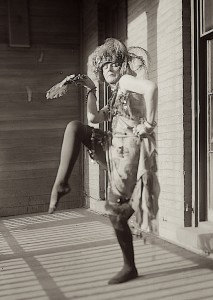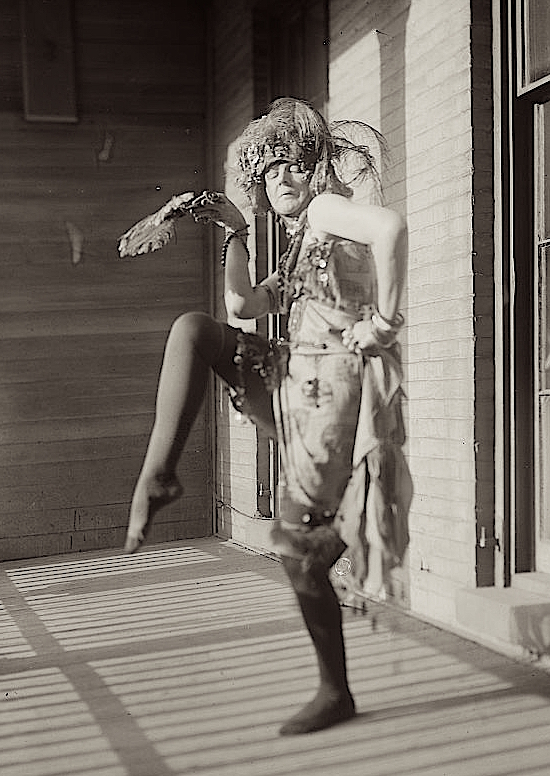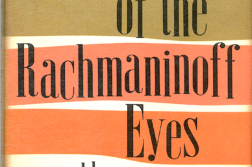A COMPLICATED and somewhat mysterious figure in early 20th-century art, the Baroness Elsa von Freytag-Loringhoven is often referred to as the “Mama of Dada.” She was a visionary performance artist whose influence can be seen in many genres related to performance and personal style today. Her epithet is due both to her involvement in the social circles of Dada artists in New York in the 1920s and to the eccentric outfits she was known for wearing around Greenwich Village.
These outfits, according to a 1997 paper by Eliza Jane Reilly, could include “an inverted coal shuttle or a peach basket on her head, and a dress of her own design that featured a bustle with a battery-powered automobile taillight. [She wore] mass-produced utilitarian objects such as tea balls, curtain rings, tin cans, and spoons. She shaved her head and dyed her scalp red, and, occasionally, pasted postage stamps on her cheeks.” Many of her friends and contemporaries wrote descriptions of her, which ranged from the admiring to the disapproving to the merely confused. Some appreciated her incorporation of found objects into her attire in the same way that they appreciated Marcel Duchamp’s “readymades.” In any case, there’s no mistaking the fact that she was ahead of her time in her attitudes about self-expression, sexuality, and art.

Eventually, she left Europe for Kentucky to start a farm with a lover, who left her shortly thereafter with no money and no connections. She met the husband who gave her the title of baroness in a German-speaking community in Cincinnati and moved with him to New York, where he soon ended the relationship and moved back to Germany. Finding herself alone again, and broke, in a strange new city, Elsa supported herself by modeling for various artists, including Man Ray and Marcel Duchamp, who became friends and collaborators. Writes Reilly about her life in New York:
The intellectual community she found in New York was open-minded, particularly with regard to gender roles, and allowed her to create a persona that would not have been tolerated in many other places. Women, in particular, found her confrontational style and her razor-sharp insight into sexual politics inspiring, and despite her preoccupation with heterosexual relationships, she received her greatest support from members of the lesbian intellectual community, including The Little Review editors Margaret Anderson and Jane Heap, and Djuna Barnes.
Barnes was a prominent lesbian author in the early 20th century, a contributor to The Little Review, a small literary journal, and, later, author of the landmark lesbian novel Nightwood (1936). It was Barnes who encouraged Freytag-Loringhoven in her experimentation in poetry, and Barnes who, after her death, worked to get her manuscripts, letters, and other unpublished writings into various university collections, and to have her poetry published. Beyond their professional relationship, the two women were also lovers for a number of years.
Later in life, Freytag-Loringhoven became increasingly poor and grew to be anti-Semitic and homophobic (despite her own bisexuality). She pushed away many of her friends, although Barnes stuck around. At this time she composed some autobiographical writings that Barnes planned to work into a biography. Although a major part of these writings concern her heterosexual love affairs, she mentions in passing an anonymous lesbian affair: “our one night together did not convince me of the thing.”
In New York, Freytag-Loringhoven experimented with the way she decorated and portrayed her body to the outside world. Often, as part of these experiments she would walk around with only minimal covering, such as sheer lace over her breasts or a very short skirt. She didn’t necessarily see this as a sexual statement, given her view of the human body as natural and unremarkable, as opposed to provocative and forbidden. Her work in the theater as a nude performer led her to question the lines between art and pornography. She soon formulated opinions about ways that she could use her body and every aspect of her life as art, rather than creating something static and unchanging. In the words of art historian Adam McKible: “For Freytag-Loringhoven, the body was an appropriate site for artistic expression, and—whether she was posing nude, decorating it with postage stamps and tin cans, using it to aggressively seduce men and women of all sexualities, or just plain fucking … she considered her body an ongoing, ever-transforming, corporeal masterpiece.”
Although she also dabbled in poetry, sculpting, and drawing, her most important work of art was her everyday life. She lived the ultimate Dadaist lifestyle. Let others recontextualize found objects by placing them in a gallery or museum; she used these objects as body ornamentation and brought this new use of objects to the public. She was arguably the first Western artist to consider her own body as art and to act upon that idea. Instead of creating an object or piece of art for a gallery setting, she created these costumes, taking the time to dress and put on makeup and hair dye, changing her entire outer image and persona for the sake of her work.
Many of the ways in which she altered her body are in style now, almost 100 years after she arrived in New York. Dyed and shaved hair, colorful makeup, and utilitarian objects as clothing accessories (think Forever 21) are in style. Whether we realize it or not, these styles bear the direct influence of Elsa von Freytag-Loringhoven, who inspired many aspects of contemporary art and design. In fashion, Jeremy Scott and his Moschino house are a prime example of her influence. He often uses everyday objects unrelated to fashion and recontextualizes them as fashion pieces or body ornamentation. He even sometimes transforms the wearer into a utilitarian object, such as his chandelier dress from his Winter 2016 collection. The dress even had electric candles that lit up while being worn, a reference to the electric headlight that Freytag-Loringhoven strapped to her chest.
Freytag-Loringhoven was one of the
pioneers of performance art, whose development she influenced significantly. Performance art is fundamentally different from theater performance, which Freytag-Loringhoven had also dabbled in. She lived her life as performance, and did it day after day, in “real time.” Rather than trying to fool an audience into believing that what was happening on a stage was reality, she incorporated her routines into the reality of everyday life.
Performance art flourished in the late 20th century, starting in the ’70s with artists such as Marina Ambromovic and Chris Burden. Ambromovic took a very similar approach to that of Freytag-Loringhoven, inviting the public to participate and to be a vital part of the performance. In her piece The Artist is Present, she invited each member of the audience to sit across from her for as long as they liked and stare into her eyes.
For Freytag-Loringhoven, it did not matter that she left behind few physical records of her art. What mattered was the performance in the moment and its effect on the people who happened upon it. There is no way to purchase her work today. This is also true of many later performance artists. Although it became easier to record the performance through film as time went on, many of these artists forbid any recording of their work, which could lead to a commodification of their art.
While Elsa von Freytag-Loringhoven was a Dada artist from the 1920s, her work is still relevant today. Certainly her outfits have lost some of their original shock value, but only because society has slowly caught up with her degree of openness in the discussion of sexuality. She is among those who opened the channels for discussion of subjects related to sexuality in general and female sexuality in particular, and their expression in the visual arts.
References
McKible, Adam. “‘Life Is Real and Life Is Earnest’: Mike Gold, Claude McKay, and the Baroness Elsa Von Freytag-Loringhoven.” American Periodicals 15 (1), 2005.
Reilly, Eliza Jane. “Elsa Von Freytag-Loringhoven.” Woman’s Art Journal 18 (1). Old City Publishing, Inc., 1997.
Elena Wise is a visual artist who works mainly with textiles, printmaking, and installations.





